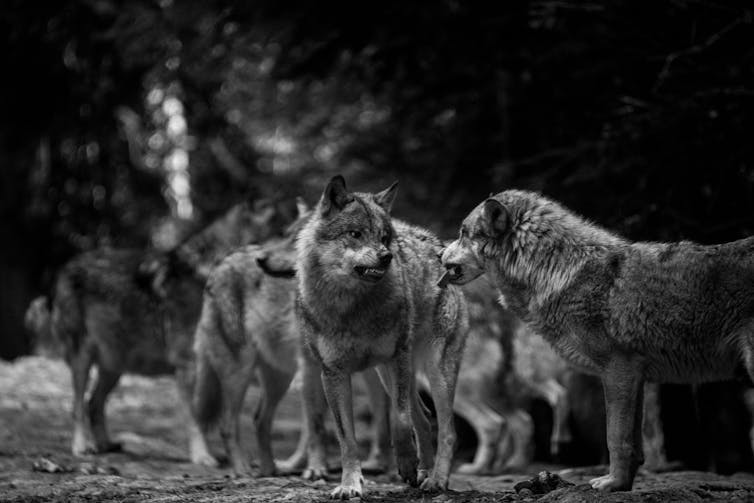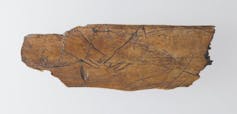Curled up on the sofa, you watch your dog snoozing nearby. Is he dreaming of the bowl of biscuits he gobbled down? Or could he be picturing the great odyssey of his forbearers, who roamed in packs across the vast steppes during the last Ice Age in search for reindeer?
The story of the ancestral ties between the dog and the wolf is one of the most exciting evolutionary sagas in humanity’s history. Not only does it invite us to examine our relationship with nature, but it also brings us back to the question of who we are as humans.
Recent advances in genetics are starting to provide key details that can help us map out the interconnected history of our loyal pets and the proud canine predators that have been gradually repopulating our countries’ hinterlands.
The science investigating the wolf-dog kinship
The timeline of the prehistoric wolf’s domestication is arguably one of the most hotly debated topics in evolutionary science. Palaeontology brings some important elements into this debate, but it is still tricky to identify the osteo-morphological analyses (i.e., the study of bone size and bone morphology) that would allow us to differentiate between proto-dog species.
Ever since Charles Darwin’s theory of evolution, we have known that a series of phenotypic changes (i.e., observable physical characteristics) can be seen in animals undergoing a process of domestication, with retained traits often favouring the more docile members of a species. Over the millennia, domestic canines have evolved shorter snouts and smaller teeth, as well as a smaller appendicular skeleton (referring to the bones of their front and hind legs).
However, the dog’s domestic nature cannot be proven by the isolated appearance of one trait in one specimen. Instead, either a series of significant variables must be observed in one individual, or a novel trait must be observed repeatedly in a population or under a given context. The problem is that full skeletons of Palaeolithic canines are extremely difficult to come by.

The field of archaeology complements this approach by gathering information on the first interactions between humans and canines. Such data points to the existence of a special link between these two types of large predators that may have begun emerging in the Upper Palaeolithic, the period broadly spanning from 50,000 to 12,000 years ago. It has been noted, for instance, that canines were used to help make jewellery; they are also present in cave art. Again, the real significance of these clues remains unclear.
Are wolves the ancestors of dogs?
Thanks to major strides in genetics in recent years, many studies of ancient DNA can help palaeontologists and archaeologists track down mysterious origins of the “first dog”. Samples from both ancient and modern canines have been taken from every continent, enabling scientists to analyse the diversity of their gene pool. The method also has the advantage of merely relying on bone fragments, rather than whole and fully preserved skeletons.
While the majority of this research focuses on mitochondrial DNA (i.e., DNA inherited solely from the maternal line, but which is less prone to degradation), a handful of studies also look at the complete genome (i.e., chromosomes inherited from the maternal and paternal lines, but which are preserved much more poorly during fossilisation).
These results help sketch a blueprint for the overall phylogenetic history of canines. Unsurprisingly, such analyses reveal a highly complex demographic and phylogenetic history of the grey wolf down through the ages. In particular, they indicate lupine populations in the Palaeolithic (c. 3.3 million years to 11,700 years ago) were able to adapt to a changing geography caused by successive glacial events in Eurasia as well as human presence.
It is now estimated that the separation of the population into several distinct lines of modern Eurasian wolves occurred approximately 40,000 to 20,000 years ago. This would mean that the Palaeolithic wolf population may have become deeply fragmented during this period, which, incidentally, matches up with the Last Glacial Maximum (also known as the “peak” of the Ice Age).

This period is all the more interesting when we consider how it coincides with Homo sapiens’ period of migration from the East and colonisation of Western Europe, as well as a sharp increase in competition between large predators.
Even more intriguingly, several studies agree on a claim that all modern Eurasian wolves descend from a single small ancient population, which is thought to have become isolated in Beringia (north-eastern Siberia) during the Last Glacial Maximum some 20,000 years ago, notably in order to flee the major climatic instabilities that had been affecting the rest of Eurasia.
But the plot thickens when we consider the question of how domestic dogs appeared. Thanks to a study into the complete genome sequences of primitive dogs from Asia and Africa, combined with a collection of samples from nineteen diverse dog breeds from across the globe, researchers have managed to ascertain that dogs from East Asia are significantly more genetically diverse than others. This model may indicate that dogs first appeared in this region following a divergence between the grey wolf and the domestic dog some 33,000 years ago. However, a 2013 study asserts that Europe was a likelier site of domestication, and that the domestication process occurred somewhere between 32,000 and 19,000 years ago.
A third study reconciles these two theories, asserting that the wolf became domesticated independently both in East Asia and in Europe before primitive Asian dogs travelled to the west, found the human populations there and replaced the indigenous dog population, some 14,000 to 6,400 years ago.
Regardless of the chosen hypothesis, we can safely deduce that when the first settlements and the first methods related to agriculture began appearing around 11,000 years ago, the dog already had at least five distinct evolutionary lines. This tells us that human societies had caused profound changes to canine populations before the end of the Palaeolithic.
As well as this, far from becoming compartmentalised, co-evolution among canines has never ceased. To this day, the wolf continues to hybridise with other canines, such as the dog and the coyote (Canis latrans). It has also interbred with the latter.
In conclusion, although question marks still hover over the geographic origin of the domestic dog and the circumstances and timeline of its domestication, developments in the study of ancient DNA now allow us to disentangle the links that bind the canines of past and present.
So, in response to the question “Do dogs descend from wolves?”, we can indeed say they do, but genetics now give us the tools to clarify which ones. Modern dogs, irrespective of their variety, all stem from a now-extinct line of prehistoric wolves that are only very distantly linked to modern wolves.
Translated from the French by Enda Boorman for Fast ForWord.
Elodie-Laure Jimenez is also affiliated with the Royal Belgian Institute of Natural Sciences. She has received funding from Belspo through the ICHIE (Interconnectivity of large Carnivores, Humans and Ice Age Environments) project.
This article was originally published on The Conversation. Read the original article.







